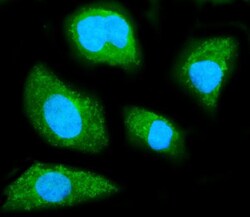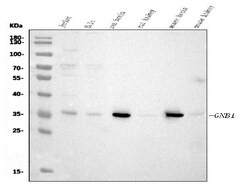Learn More
Invitrogen™ GNB1 Monoclonal Antibody (11F9)
Mouse Monoclonal Antibody
Supplier: Invitrogen™ MA549277
Description
Adding 0.2 mL of distilled water will yield a concentration of 500 μg/mL. Immunogen sequence is identical to the related mouse and rat sequences. Positive Control - WB: human Jurkat whole cell, human Hela whole cell, rat brain tissue, rat kidney tissue, mouse brain tissue, mouse kidney tissue. ICC/IF: SiHa cell. Store at -20°C for one year from date of receipt. After reconstitution, at 4°C for one month. It can also be aliquotted and stored frozen at -20°C for six months. Avoid repeated freeze-thaw cycles.
Vision involves the conversion of light into electrochemical signals that are processed by the retina and subsequently sent to and interpreted by the brain. The process of converting light into an electrochemical signal begins when the membrane-bound protein, rhodopsin, absorbs light within the retina. Photoexcitation of rhodopsin causes the cytoplasmic surface of the protein to become catalytically active. In the active state, rhodopsin activates transducin, a GTP binding protein. Once activated, transducin promotes the hydrolysis of cGMP by phosphodiesterase (PDE). The decrease of intracellular cGMP concentration causes the ion channels within the outer segment of the rod or cone to close, thus causing membrane hyperpolarization and, eventually, signal transmission. Rhodopsin activity is believed to be shut off by phosphorylation followed by binding of the soluble protein, arrestin. Transducin, once activated by rhodopsin, promotes the hydrolysis of cGMP by PDE. The subunit composition of transducin differs between different photoreceptor cells. Rod transducin consists of rod transducin alpha (Tr alpha), T beta, and T gamma. Cone transducin is composed of cone transducin alpha (Tc alpha), T beta and T gamma. Differential transducin subunit composition of transducin is believed to be responsible for the different light sensitivities between photoreceptive cells.
Specifications
| GNB1 | |
| Monoclonal | |
| 500 μg/mL | |
| PBS with 4mg trehalose and no preservative | |
| P54311, P62873, P62874 | |
| GNB1 | |
| A synthetic peptide corresponding to a sequence at the N-terminus of human GNB1 (2-42aa SELDQLRQEAEQLKNQIRDARKACADATLSQITNNIDPVGR). | |
| 100 μg | |
| Primary | |
| Human, Mouse, Rat | |
| Antibody | |
| IgG2b |
| Western Blot, Immunocytochemistry | |
| 11F9 | |
| Unconjugated | |
| GNB1 | |
| AA409223; beta subunit, signal-transducing proteins GS/GI; C77571; G protein subunit beta 1; gbb1; GNB1; Gnb-1; gnb1 protein; gnb1a; guanine nucleotide binding protein (G protein), beta 1; guanine nucleotide binding protein (G protein), beta polypeptide 1; guanine nucleotide binding protein (G protein), beta polypeptide 1a; guanine nucleotide binding protein, beta 1; Guanine nucleotide-binding protein beta 1; guanine nucleotide-binding protein G(I)/G(S)/G(T) subunit beta-1; guanine nucleotide-binding protein, beta-1 subunit; MRD42; T beta; testicular tissue protein Li 72; transducin beta chain 1; transducin beta subunit; unnamed protein product; wu:fb50b09; wu:fj94h04 | |
| Mouse | |
| Antigen affinity chromatography | |
| RUO | |
| 14688, 24400, 2782 | |
| -20°C | |
| Lyophilized |
Your input is important to us. Please complete this form to provide feedback related to the content on this product.

